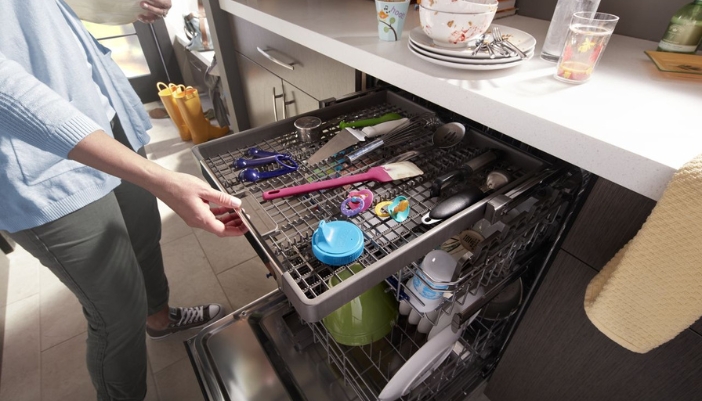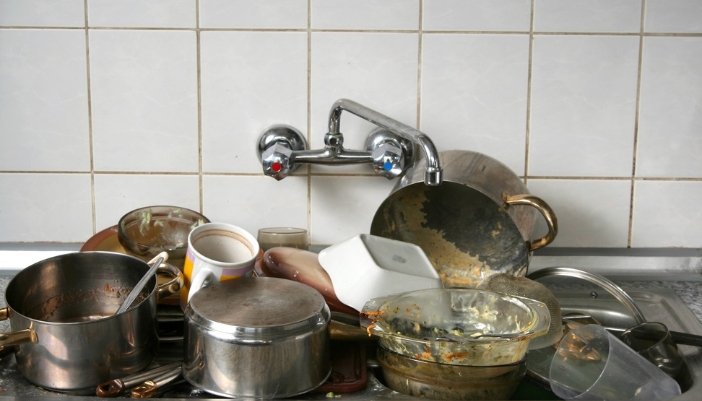
Loading dishwashers efficiently not only saves time, but ensures that your dishes come out sparkling clean. If you're wondering how to load a dishwasher properly, this article will guide you through the process step-by-step:
- Preparing the dishwasher
- Sorting and organizing utensils
- Plates and bowls
- Glasses and cups
- Pots, pans, and cookware
- Cutlery and silverware
- Other dishwasher-safe items
- Closing and running the dishwasher
By following these instructions, you'll optimize space, maximize cleaning efficiency, and maintain the longevity of your dishwasher.

Preparing the Dishwasher
Before you begin, in order to make sure your dishwasher runs smoothly, be sure to remove any leftover food particles from the filter and check for blockages in the spray arms. Also, make sure that there are no obstructions inside the dishwasher that would prevent it from doing its job.
Sorting and Organizing Utensils
To streamline the unloading process later, sort and organize your utensils. Place forks, spoons, and knives in separate compartments of the utensil basket. You can also use a cutlery tray with separate sections for each type of utensil, which makes it easier to retrieve them after they've been washed.
Loading Plates and Bowls
When loading plates and bowls, position them at an angle to facilitate proper water circulation. Place larger plates at the back, smaller ones at the front, and make sure they don't overlap. Be sure to leave enough space between each dish to prevent them from touching (or potentially chipping).
Arranging Glasses and Cups
Glasses and cups should be loaded in the top rack of the dishwasher. Ensure they are securely placed upside down, allowing water to reach the inside of them for thorough cleaning. For delicate glassware, use stemware holders or silicone sleeves to prevent them from moving around during the wash cycle.

Adding Pots, Pans, and Cookware
Place larger items such as pots, pans, and baking sheets on the bottom rack of the dishwasher. Angle them to allow water to flow freely and ensure any leftover food particles are rinsed off. Make sure the items are not blocking the spray arms or preventing the detergent dispenser from opening.
Placing Plastic Containers and Tupperware
Plastic containers and Tupperware are best placed on the top rack. Secure them by leaning them against the dishwasher's walls or using clips to prevent them from flipping over. Avoid overcrowding to allow water and detergent to reach all surfaces and eliminate any lingering odours.
Adding Cutlery and Silverware
When loading cutlery and silverware, alternate the handles up and down to prevent nesting. This helps ensure that water can reach all sides for effective cleaning. There are also designated compartments in the utensil basket or tray that you can use to keep them separate.
Loading Additional Dishwasher-Safe Items
Take advantage of your dishwasher's versatility by loading additional dishwasher-safe items such as oven racks, stove grates, and range hood filters. Always check the manufacturer's instructions to ensure that these items are suitable for dishwasher cleaning.
Closing and Running the Dishwasher
Once you've loaded all the dishes, cups, and utensils, double-check that the spray arms are free of obstruction. Fill the detergent dispenser and close the dishwasher door securely (avoid slamming the dishwasher door, as it may dislodge some of your dishes or affect the seal).
To ensure a thorough clean, it's important to choose the right wash cycle and add appropriate options based on the level of grime and your dishwasher's features. To conserve water and energy, it's recommended to use eco-friendly or energy-saving dishwasher models. You can also select certain modes when running a half-full dishwasher that will prevent the overuse of energy.
Then, all you have to do is press the start button and let the dishwasher do its magic!
Frequently Asked Questions (FAQs)
Q: Can I put stainless steel pots and pans in the dishwasher?
A: Most stainless-steel pots and pans are dishwasher safe. However, it's best to check the manufacturer's instructions to ensure they can withstand dishwasher cleaning.
Q: Should I rinse my dishes before loading them into the dishwasher?
A: Lightly scraping off food particles is sufficient. Pre-rinsing dishes can even reduce the effectiveness of the dishwasher detergent.
Q: Can I wash wooden cutting boards in the dishwasher?
A: It's generally not recommended to put wooden cutting boards in the dishwasher as it can cause warping or cracking. It's best to wash them by hand.
Q: How often should I clean the dishwasher filter?
A: Once a month is generally recommended. However, if you notice decreased cleaning performance, it might require more frequent cleaning.
Q: Can I use regular dish soap instead of dishwasher detergent?
A: No, regular dish soap is not suitable for dishwashers. It creates excessive suds and may cause overflow. Always use dishwasher detergent for optimal results.
Knowing how to load a dishwasher correctly will save you time and ensure your dishes are thoroughly cleaned. By following the steps outlined in this article, you can maximize space, improve cleaning efficiency, and maintain your dishwasher's longevity. If, however, you find yourself in need of a new dishwasher, we have many models and brands to serve your needs. Our experts would be happy to help you find the one that’s best for you – reach out to us or come visit us in-store today!